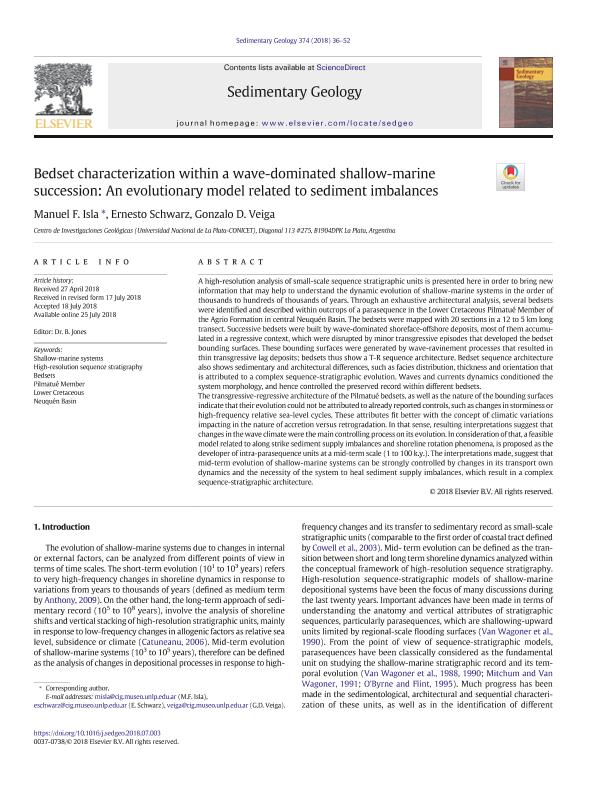Mostrar el registro sencillo del ítem
dc.contributor.author
Isla, Manuel Fermín

dc.contributor.author
Schwarz, Ernesto

dc.contributor.author
Veiga, Gonzalo Diego

dc.date.available
2019-08-09T21:37:56Z
dc.date.issued
2018-10
dc.identifier.citation
Isla, Manuel Fermín; Schwarz, Ernesto; Veiga, Gonzalo Diego; Bedset characterization within a wave-dominated shallow-marine succession: An evolutionary model related to sediment imbalances; Elsevier Science; Sedimentary Geology; 374; 10-2018; 36-52
dc.identifier.issn
0037-0738
dc.identifier.uri
http://hdl.handle.net/11336/81364
dc.description.abstract
A high-resolution analysis of small-scale sequence stratigraphic units is presented here in order to bring new information that may help to understand the dynamic evolution of shallow-marine systems in the order of thousands to hundreds of thousands of years. Through an exhaustive architectural analysis, several bedsets were identified and described within outcrops of a parasequence in the Lower Cretaceous Pilmatué Member of the Agrio Formation in central Neuquén Basin. The bedsets were mapped with 20 sections in a 12 to 5 km long transect. Successive bedsets were built by wave-dominated shoreface-offshore deposits, most of them accumulated in a regressive context, which were disrupted by minor transgressive episodes that developed the bedset bounding surfaces. These bounding surfaces were generated by wave-ravinement processes that resulted in thin transgressive lag deposits; bedsets thus show a T-R sequence architecture. Bedset sequence architecture also shows sedimentary and architectural differences, such as facies distribution, thickness and orientation that is attributed to a complex sequence-stratigraphic evolution. Waves and currents dynamics conditioned the system morphology, and hence controlled the preserved record within different bedsets. The transgressive-regressive architecture of the Pilmatué bedsets, as well as the nature of the bounding surfaces indicate that their evolution could not be attributed to already reported controls, such as changes in storminess or high-frequency relative sea-level cycles. These attributes fit better with the concept of climatic variations impacting in the nature of accretion versus retrogradation. In that sense, resulting interpretations suggest that changes in the wave climate were the main controlling process on its evolution. In consideration of that, a feasible model related to along strike sediment supply imbalances and shoreline rotation phenomena, is proposed as the developer of intra-parasequence units at a mid-term scale (1 to 100 k.y.). The interpretations made, suggest that mid-term evolution of shallow-marine systems can be strongly controlled by changes in its transport own dynamics and the necessity of the system to heal sediment supply imbalances, which result in a complex sequence-stratigraphic architecture.
dc.format
application/pdf
dc.language.iso
eng
dc.publisher
Elsevier Science

dc.rights
info:eu-repo/semantics/openAccess
dc.rights.uri
https://creativecommons.org/licenses/by-nc-sa/2.5/ar/
dc.subject
Bedsets
dc.subject
High-Resolution Sequence Stratigraphy
dc.subject
Lower Cretaceous
dc.subject
Neuqué;N Basin
dc.subject
Pilmatué Member
dc.subject
Shallow-Marine Systems
dc.subject.classification
Geología

dc.subject.classification
Ciencias de la Tierra y relacionadas con el Medio Ambiente

dc.subject.classification
CIENCIAS NATURALES Y EXACTAS

dc.title
Bedset characterization within a wave-dominated shallow-marine succession: An evolutionary model related to sediment imbalances
dc.type
info:eu-repo/semantics/article
dc.type
info:ar-repo/semantics/artículo
dc.type
info:eu-repo/semantics/publishedVersion
dc.date.updated
2019-07-24T17:42:06Z
dc.journal.volume
374
dc.journal.pagination
36-52
dc.journal.pais
Países Bajos

dc.journal.ciudad
Amsterdam
dc.description.fil
Fil: Isla, Manuel Fermín. Consejo Nacional de Investigaciones Científicas y Técnicas. Centro Científico Tecnológico Conicet - La Plata. Centro de Investigaciones Geológicas. Universidad Nacional de La Plata. Facultad de Ciencias Naturales y Museo. Centro de Investigaciones Geológicas; Argentina
dc.description.fil
Fil: Schwarz, Ernesto. Consejo Nacional de Investigaciones Científicas y Técnicas. Centro Científico Tecnológico Conicet - La Plata. Centro de Investigaciones Geológicas. Universidad Nacional de La Plata. Facultad de Ciencias Naturales y Museo. Centro de Investigaciones Geológicas; Argentina
dc.description.fil
Fil: Veiga, Gonzalo Diego. Consejo Nacional de Investigaciones Científicas y Técnicas. Centro Científico Tecnológico Conicet - La Plata. Centro de Investigaciones Geológicas. Universidad Nacional de La Plata. Facultad de Ciencias Naturales y Museo. Centro de Investigaciones Geológicas; Argentina
dc.journal.title
Sedimentary Geology

dc.relation.alternativeid
info:eu-repo/semantics/altIdentifier/doi/http://dx.doi.org/10.1016/j.sedgeo.2018.07.003
dc.relation.alternativeid
info:eu-repo/semantics/altIdentifier/url/https://www.sciencedirect.com/science/article/pii/S0037073818301702
Archivos asociados
